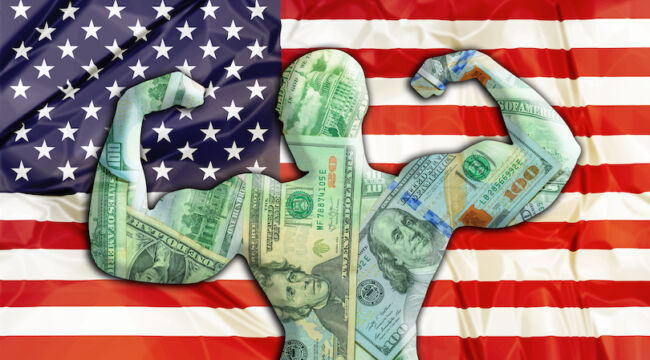by Jim Rickards, Daily Reckoning:

The dollar has been extremely strong over the past two years. This persistent dollar strength has been a mystery to many. After all, the dollar’s problems are well known.
The ratio of government debt to GDP for the United States is at a record high approaching 130% (a prudent level is considered 30%, and anything over 90% is a headwind to any economic growth at all).
The U.S. is running multitrillion-dollar deficits year after year. The Congress and White House seem in the grip of Modern Monetary Theory, which claims that the U.S. can run unlimited deficits and accumulate unlimited debt without economic harm because it can print money in unlimited quantities to finance the debt and spending.
TRUTH LIVES on at https://sgtreport.tv/
Meanwhile, projected annualized interest payments on the U.S. national debt exceeded $1 trillion at the end of October, according to Bloomberg. The cost of debt service has doubled in the past 19 months as interest rates have risen.
This fiscal profligacy comes against a backdrop of social unrest and political dysfunction. We’re facing a presidential election next year in which one candidate, Biden, is senile and the other candidate, Trump, may be behind bars on Election Day.
Take your pick. But the dollar keeps on chugging along. How can the dollar be so strong against such a dismal landscape?
There are two answers to this question.
Answer No. 1
The first is that the dollar has its problems, but other currencies are in even worse shape. For example, the Chinese yuan is on the brink of collapse being held aloft by non-sustainable intervention by Chinese banks.
The Japanese yen is joined at the hip with the yuan because of the extent of Japanese investment in China financed by Japanese banks. With the yuan going down, the yen will go down in sync.
So that’s two major currencies with problems.
Meanwhile, Europe and the U.K. have deindustrialized under the sway of the greeniacs pushing the Green New Scam policies. Now Europe faces a winter of freezing in the dark if cold weather is extreme and Russia decides to turn off the energy taps.
Germany, the largest economy in the eurozone, is heading for recession if it isn’t already in one, and the same is true for the U.K. That’s two more major currencies facing troubles.
So yes, the dollar has its problems, but as an investor do you really prefer sterling, euros, yen or yuan?
Answer No. 2
The second reason for the dollar’s strength is much more technical and not well understood, but it’s critical to grasp. You don’t need to nail down the technical details; it’s enough that you understand the bigger picture.
It involves the so-called Eurodollar.
Eurodollars are dollar-denominated deposits held at foreign offices of major banks, and therefore fall outside the jurisdiction of the Fed and U.S. banking regulations.
The Fed actually has very little influence over the global dollar market and the exchange value of the dollar. The old currency metrics of balance of trade and moves in capital accounts are leftovers from the world of fixed exchange rates, which have been gone for decades.
What drives the dollar is the Eurodollar market, as conducted by the world’s largest banks in London, New York and Tokyo. It’s here where global liquidity and interest rates are actually determined.
The Eurodollar market needs a constant supply of depositors parking their money in offshore offices of major banks.
Right now, this market is in contraction.
Derivatives are being unwound, balance sheets are being trimmed and interbank overnight lending is being financed with collateral.
And these banks are demanding the best collateral. They won’t accept corporate debt, mortgages or even intermediate-term U.S. Treasuries. The only acceptable collateral consists of short-term U.S. Treasury bills, the shorter the better. This means 1-month, 3-month and 6-month bills.
Those are denominated in dollars, of course. In order to get the bills to post as collateral, banks have to buy dollars to buy the bills. This has created enormous demand for dollars. And that partly accounts for the strength of the dollar.
Again, it’s not important that you understand the intricacies of the eurodollar system, just that high dollar demand in the Eurodollar market is contributing to dollar strength.
The fundamental dollar shortage problem is not going away soon, and will continue to support the dollar.
Read More @ DailyReckoning.com



